
| You may prefer to see these pages as a photo slide show which contains the same text but presents the pictures full screen size. If so, click on the slides presentation at the right. |

Let's start though a bit to the south of Hvar. After our Dubrovnik
visit, we ventured north along the Dalmatian coast. Views such as the
above are typical: communities hug the shores and over a 1000 islands,
many of them inhabited, rise steeply from the Adriatic. Except for the
southernmost islands and coast where Dubrovnik was able to hold its
independence, the rest of Dalmatia became Venetian territory starting
in the 12th century.

Long before that, crashing tectonic plates created most impressive
ridges along the 400-mile-long Dinaric Alps as they laced the edge of
the eastern Adriatic with craggy islands and shores. Natural barriers
such as this have historically kept the area "Balkanized" into separate
states not known for getting along. Bosnia in particular has trouble
getting to the sea.

Above is one of the more dramatic views of these limestone ridges with
a thumbnail of population below. Venice used these harbors to supply
its ships -- with water, food, and oarsmen. Venetians discouraged
education and culture. They mostly wanted supplies and muscle.Along
most of the Dalmatian coast, these ridges parallel the Adriatic,
keeping Bosnia on the other side from the sea only a few miles away.
But here the fault shifts to provide some sea access where the Neretva
River carves its way to the sea.

Limestone generally does a lousy job of holding water so lakes such as
these are a rarity along the Dalmatian coast. Typically water corrodes
the limestone, creating channels and drainage. Instead here it has
formed 100-foot-deep reservoirs. These are the 7 interconnected Baćina
Lakes which border the coast at the city of PloÄe at the mouth of the
Neretva River.The Dinaric Alps in the background are a nearly
insurmountable barrier between the inland agricultural areas and the
Adriatic. Besides this Neretva River valley, the only other pass
through them is the Krka River canyon to the north. Bosnia would do a
lot to get their hands on this territory and PloÄe's nearby port (where
95% of the population is Croat.) Negotiations continue.

Here we see an example of effective irrigation of the topsoil brought by the Neretva River to its delta.

But this view is more typical: forested mountains plunging steeply into
the sea with perhaps a small town clinging near the edge -- and nary a
field in sight.

Usually limestone meets shore without interruption. Occasionally you
might see a small beach as is the case here. About 12,000 years
ago, global warming led to the rise of the Adriatic which converted
this area of the Dinaric Alps into islands -- long before Al Gore was
invented.

Road building is taken seriously here and tunnels are not uncommon.
This road led us from Dubrovnik to Split where we took a ferry to the
island of Hvar, a hot destination for European beachcombers.

Hvar has a lot of history -- and a lot of prehistory. It has been populated at least since Neolithic times.
Note the terrace farming here preserves the rain water that would otherwise quickly drain through the limestone karst in the valleys.The Dalmatian islands are typically parts of the Dinaric Alps whose gulches were filled in by the rising Adriatic sea about 12,000 years ago.
Agricultural and herd animals arrived here, most likely from Italy, around 6000 BC. Typically with agriculture you get pots as you have to keep that grain somewhere. The late Neolithic Hvar culture flourished here for a millennium starting around 3500 BC. The Adriatic coast has over 50 archeological sites with fragments from their black pots. Hvar alone has 17 Neolithic archeological sites.

Here's another view of the terraces, some of which are UNESCO World
Heritage sites as examples of Greek agriculture. Some have been in
continuous use forever, if not longer.
Terrace farming is important to preserve the rainwater (about 27" per
year -- not all that different from the US Midwest area). But scarce
fresh water disappears quickly through the porous limestone. The soil
is not suitable for raising grain, but works well with vines and, as we
see at the bottom of this picture, olive trees...

...but often lavender makes for a more lucrative crop although it takes
some tending. While Napoleon was in the neighborhood, the
lavender crop mushroomed to serve the French appetite for perfume. Much
of this area has an abandoned feel to it, and typically the lavender
terraces seem a bit scruffy.
Since the Venetians brought vines in the 12th century, wine was also an important export but, as in France, the phylloxera critters wiped out the industry and many of the island's agricultural workers left. The slopes and sun -- along with strong winds that keep insects at bay -- make this excellent wine country and Hvar's wine industry has made a strong comeback. (Croatian and Hungarian wines -- dismissed for years as Eastern Block schlock-- are suddenly in vogue.) But sometimes the winds (named "Bura" for the North and "Yugo" for the south) are so strong that those who labor in the vineyards must be tied together with ropes.

Out of the over 1000 Dalmatian islands, Hvar is unusual for having both
fresh water springs and large coastal plains. No surprise then that
this isle was inhabited early, maybe even before it became an island
about 12,000 years ago. Once people started to settle down with
agriculture, they needed a place to stay. Besides inventing the wheel,
Neolithic man figured out how to stack stones to create shelters with
roofs and sides that repel water. Like the wheel, it was obvious how to
do it in hindsight. Like wheels, these "trims" are typically round to
avoid issues like corners, (although that's not apparent from this
picture.) Today these mortar-less structures look like so many stone
igloos dotting Hvar's ancient stone-walled terraces. If you're into
this kind of stuff, Zagreb theoretical physicist Berislav Horvatić who
appears to be both a rock and a rocket scientist has an excellent
page which can be reached by clicking here.

Preservationists are a bit incensed that an airport has been proposed
for part of the UNESCO World Heritage site of agricultural fields
terraced by rock fences from Greek times.
Throughout the island, we witnessed further rock construction in progress.
The Greeks arrived in 385/4 BC, bringing the local indigenous tribes into history (writing) and a market economy. The Greek colonization of the East Adriatic was not particularly intensive; but two centuries later, this island was well positioned as part of the Roman Empire which saw free movement of people and goods along the entire Mediterranean and along the Atlantic from Africa to Scotland.

Some Hvar residents still work in marble quarries. (Several guides
informed us that the US White House was made from stone from Hvar but
when the New York Times published that factoid on the front page of its
travel section a few years ago, historians corrected the paper of
record. But guides here are not about to abandon the story. Weapons of
mass destruction, anyone?)
At the north end of the island is Grabak Cave, a major Neolithic archeological site which once held many pottery fragments, knives, copper tools, and human and animal bones -- most of which are now a ferry ride away in a museum in the mainland city of Split. Descendants of this cave continued to be the majority of the inhabitants of Hvar island long after the Greeks arrived. Most archeological sites in Hvar are in caves -- not that all of the Neolithic tribes lived there. It's just that those on the plains most likely had their remnants wiped by the elements (remember those winds?)

Is it any wonder that the Greeks had to terrace to keep the rainwater from escaping through the limestone karst?

Conde Nast Traveler calls Hvar a 3-S tourist destination: Sun, Shore,
and Sex. Instead we found here a 2-S site: Stari Grad and a lot of
Stones just like the nearby stone-fenced Stari Grad Plain, the UNESCO
agricultural site. Unfortunately, the Stari Grad ruins were the biggest
disappointment of the trip, as only a few undocumented piles of stones
mark the archeological site. Come to think of it, the sun and shore
weren't all that great either, in my humble eStimation.
A long bay on the north side of the island creates an excellent natural harbor leading to this spot. Greeks from Syracuse (Sicily) started a colony here called Pharos in the 4th century BC, making this one of the oldest civilized spots in Europe. When it founded its colony of ΦαÏος, Syracuse was probably the most important Greek city on the Mediterranean and at the peak of its power. War with Carthage would soon follow. Eventually the Greeks invited the Romans into Dalmatia to help them maintain their power. Not that good of an idea.

Invite is a bit of a misnomer as this island resisted the 219 BCE
onslaught of the Romans and were punished severely for it. (This was
typical for the Romans.) Over the next 600 years, Romans pretty
well controlled their province of Dalmatia -- but only in the cities
and towns. The countryside remained native and tribal.
Here, as in the rest of Croatia, the southern Slavs eventually swarmed in. When Venice finally got control, it moved the capital from Pharos (now called "Stari Grad" ) to the southwestern side of this thin island.
Above is the 17th century church of St. Stephen whose facade, like that of many churches throughout Dalmatia, dimly echoes that of the resplendent St. Zaccaria in Venice.

St. Stephen's was locked up, leaving us to admire this doorway with a
pope memorialized between two half shells overhead. This depicts Pope
St. Stephen -- not the martyr we usually see depicted sprouting arrows
like a porcupine. Instead, this Stephen was the 3rd century Pope who
invented mass vestments. (Before that priest wore street clothes. While
this may not be world peace, it has endured much longer: Today
Stephen's sole brother Benedict XVI wears Prada loafers.)
This church replaced a 12th century church on the same spot -- and used stones from the city's defensive walls. The Venetians constructed the first church of St. Stephen as part of a Benedictine monastery.

Above we see one of the few windows that break St. Stephan's ashlar wall.
Construction started in 1604 and continued for over a century. The Venetians fought with the Byzantine empire, Hungary, and Croatia from the 12th century until 1409 when they more-or-less settled the matter. In fact, when Venice began to dominate the Dalmatian coast, these islands in the center of the then-known world had had over 30 changes of control including Greeks, Romans, Tatars, Croats, Serbia, and the Byzantine Empire. Nice of the Greeks to introduce history here, but it's hard to keep up with it all.
For nearly 4 centuries under Venetian rule, the island prospered economically, even if it occasionally rebelled politically. The Hapsburgs ended the Venetian Republic in 1797 followed a decade later by Napoleon and his crew. Then came the dog's breakfast of rulers that ended in Yugoslavia. Except, of course, it didn't end in Yugoslavia. Today the island is back as part of Croatia.

The old town ("Stari Grad") is filled with stone houses which we found
mostly closed-up in the rain -- despite the fact that the tourist
office claims this to be the sunniest spot in Europe. (It averages over
7 hours of sun per day.)
This island supports itself by producing excellent red and white wines, lavender -- and, of course, tourism.

Although an island, Hvar was often at the center of culture such as the
Croatian literary Renaissance. One of its major figures is Petar
Hektorović whose statue rises in front of his imposing stone house he
designed facing the port in Stari Grad. Today it's an ethnographic
museum.
The Croatian literary renaissance was a 15th and 16th century movement that saw Croat writers who had been using Latin --Hektorović had translated Ovid -- begin to write using their native tongue. Their subject matter included contemporary life, local folk lore, and common people.

Hektorović was such a noble whose poetry glorified the common man. He
was born and died in Stari Grad, where he built the fortified house
shown above around 1520, calling it "Tvrdalj Castle." (His family was
among the wealthiest here and he had a much different summer home in
Hvar town that we will see in a few slides.) The pond contains sea
water as is often the case in coastal gardens where fresh water is in
short supply. It flows under the "fort" to an interior atrium and
garden.
Hektorović wrote in both Latin and Italian, but his masterpiece was in the local Croatian dialect, describing a fishing trip around the island. This in the seas where wily Ulysses sailed. Hektorović did eclogues, not epics.

Let's now leave the old town of Stari Grad and venture to the southeast
section of the island to the town of Hvar. The long quay reaching out
into the harbor at the center of the picture was built by the Venetians
to moor their fleet. At upper right are some of the 20 Pakleni Islets,
where forests meet beach and those with boats or water taxi can
experience both. The name is mistakenly thought to translate as "Hell's
Islands," and some is raised there.
In 385 BCE, the Greeks also settled here in a town they named "Dimos." Most likely this was a trade center between such great Greek cities as Corinth and the interior of Bosnia-Herzegovina. With the arrival of the Greeks, the natives, perhaps descendant from the cave dwellers, retreated to the hills in the island's interior. To keep them there, the Greeks built walls. (Traces exist today but scholars dispute whether the natives built these earlier to keep the Greeks out. Myth holds that these walls were built by giants such as Odysseus's Cyclops.)

The local tribes of Illyrians eventually took the island back from the
Greeks but held it for less than a generation before the Romans took
over in 219. They came to stamp out the pirates based here that were
menacing Adriatic shipping. They created villas with mosaic floors that
are still being excavated today. When the Western Roman empire
collapsed, the eastern Roman (Byzantine) empire took over in 535 -- but
local bishops kept Dalmatia Catholic, not Orthodox.
Dubrovnik (Ragusa) dominated the island. Byzantine rule never quite took, especially after the Slavs swept through the Neretva river valley (remember those lakes we saw earlier) and populated Dalmatia during the 7th century. They stayed while Byzantine kept conquering and losing the same territory. Finally Croatia became a vassal of Hungary (but administratively somewhat independent) in 1102.
Then came Venice.

Hvar willingly gave itself over to Venice in the 12th century in
exchange for protection. When the Venetians took over in 1278, they
moved the island capital here in what is now the town of Hvar.
Three hills descend to a lovely harbor which laps the town square. While hovercraft land here, this appears today to be more a marina than port. The island's major port has stayed on the other side of the island at Stari Grad.
In the summer, this basin is pretty much a parking lot for 3-S yachts as this is Croatia's most in sin resort.

The Venetians moved the capital here as it was easier to defend than
Stari Grad. If you come by road, this is what Hvar town looks like on
first sighting -- the Spanish fort and a piece of the crenellated town
wall erected by the Venetians.
The town was allowed to govern itself within these walls.
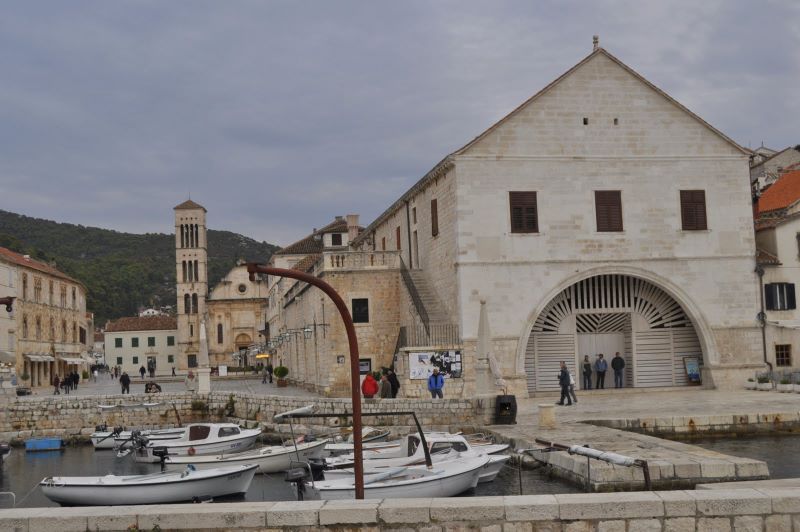
Walls protected the town on the land side. To protect the sea entrance,
the Venetians constructed an arsenal to support both the city's defense
as well as shipbuilding. The building at right is a newer arsenal built
from 1579-1611 after the invading Turks burnt down its predecessor. Its
huge arched entrance allowed ships to be taken inside in times of
danger.
The Turks burnt down almost all of the town in 1571 as they rowed their way to their defeat at the Battle of Lepanto. Their commander, Uluz Ali -- the governor of Algiers -- brought 80 galleys here as a diversionary tactic. He sailed around Hvar island, trashing all its cities before proceeding south to Corfu.
Later one of the oldest surviving theaters in Europe was built inside the Arsenal in 1612. Called the "Kazaliste," it further solidified Hvar as a center of the Croatian Renaissance with the homes of Hanibal Lucic, Petar Hektorvic, and Gian Francesco Biondi. The town square at left leads to the cathedral and its iconic Dalmatian bell tower.
(Thanks to Frederic Chapin Lane's "Venetian Ships and Shipbuilders of the Renaissance" for this drawing.)
Above is the main reason that Venice wanted Hvar. While their galleys were great ships for getting into and out of military situations and tight harbors, including the Venice Lagoon, they were labor intensive -- which meant water intensive as that labor sweated in the Mediterranean heat. When not at war, these ships transported cargo so safely that they routinely "sailed" without insurance.
Speed required that they be long: eight times as long as they were wide. That meant they would tip easily if loaded with cannons high enough to do damage. Because of that, they eventually became obsolete.
Most used three banks of oars on each side powered by rowers on benches angled so seat mates wouldn't interfere with each other. Oars -- one per rower --weighed about 120 pounds each and were rarely operated by slaves. Typically there was enough room at the end of each bench for a single bowman/marine.
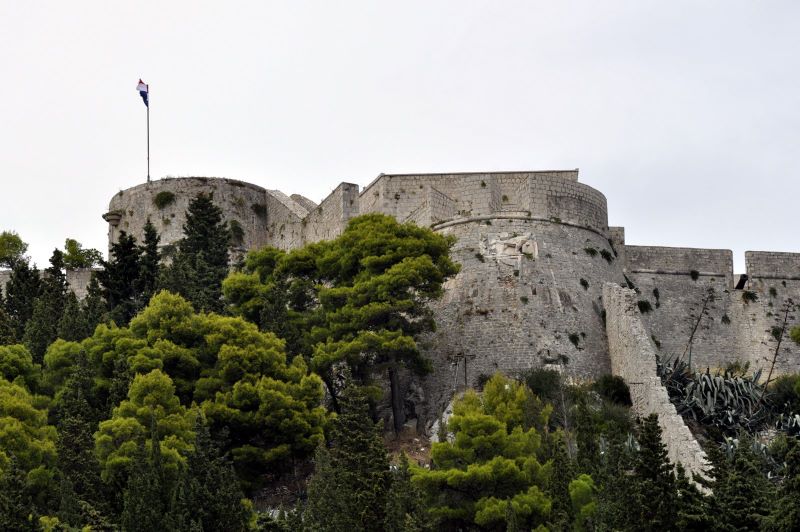
At the other end of the island, the Venetians fortified their churches.
But they couldn't hold the island and Hungary-Croatia took the island
back in 1358, followed by Bosnia -- which was eventually defeated by
the Ottomans in 1389. But the Ottomans couldn't hold Dalmatia and
finally the Venetians got Hvar back despite Dubrovnik (Ragusa) and
Split both fighting for it.
But even Venice's hold was tentative and they erected the Spanish Fort between 1531 and 1551, 358 feet above the town, in anticipation of an attack by the Ottoman Turks. (They arrived 20 years later). But not all enemies were from beyond the island shores. Hvar denizens revolted against their Venetian masters several times.

When Venice fell to Napoleon in 1797, he gave Dalmatia to the Austrians
who built their barracks inside this castle. When Austria, in turn fell
after the Battle of Austerlitz in 1805, the French took Hvar back. This
in turn brought out the Russians who bombarded the island a few years
later.
A pleasant walk through aloe and scrub bush leads to the above fort built by Spanish engineers during the 16th century and called the Spanish Fort ever since. (Spain has spent the centuries before mostly attacking the Moors in a successful attempt to get them out of Andalusia.)
Hvar residents survived the Ottoman onslaught in 1571 by taking refuge here. Before this fort, a medieval castle occupied this obviously strategic high ground.
Our luck was not as good. We found the fort closed due to high winds -- but not so high that we couldn't easily walk up here on a sunny mid-October afternoon. Fortunately, no Ottoman Turks were to be found.
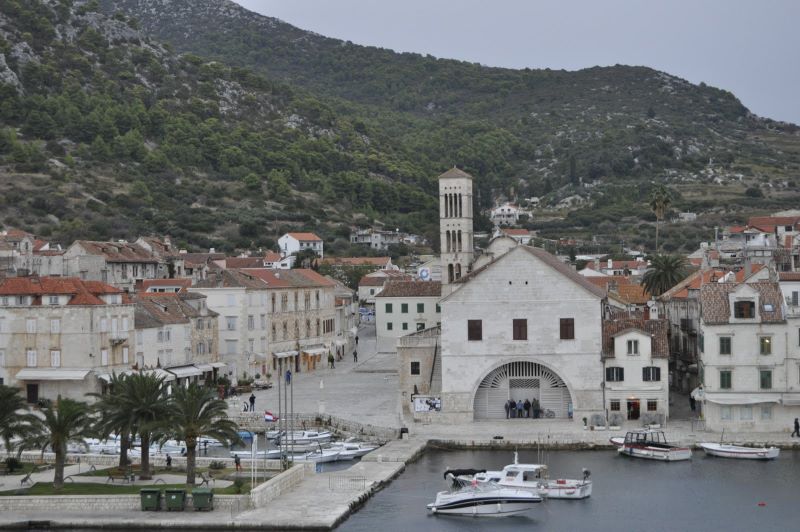
With Hvar, the Venetians had safe harbor halfway between Venice and
Corfu. Galleys stored little food and water and navigation in open
water was rare. Ships clung to the shore. Hvar was well positioned to
supply the 2 gallons of water needed per day for Venetian galleys that
held over 200 sailors/rowers. Venice also built the tiny enclosed
marina at the foot of the plaza at left which today is still called
Mandrac (Greek for a sheepfold.) The town prospered and nobles built
their Gothic and Renaissance palaces right into the city walls. Venice
used this as one of its naval bases until 1776.

The Arsenal is at center left of this picture. The Venetians moored
their Adriatic fleet here along the long quay where today the
glitterati moor their yachts.
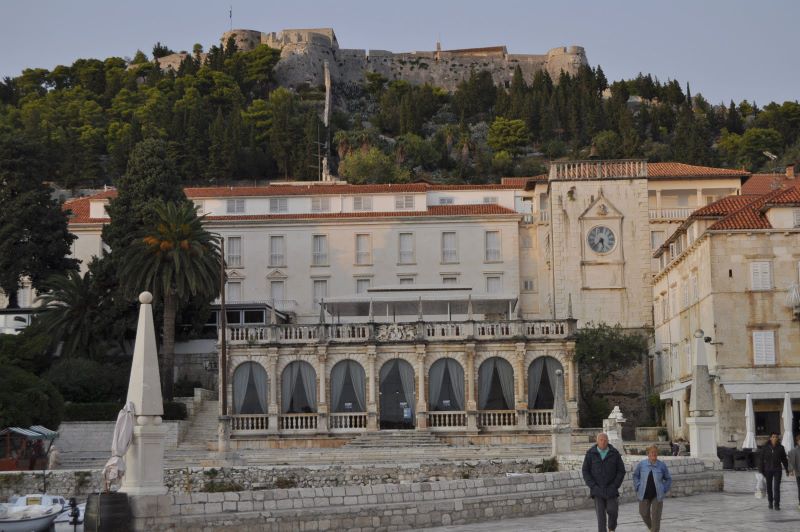
Besides being the sunniest spot in Europe, Hvar is known for the
Venetian Renaissance buildings edging its main square. Here we look
north at the loggia and clocktower of the Rector's palace (equivalent
to city hall) at the bottom of the hill protected by the Spanish Fort.
These remnants are now part of a hotel once favored by Elisabeth,
Empress to Franz Joseph, during the 1800s.
The Habsburgs ran Dalmatia from 1815 until Austria-Hungary's collapse at the end of WWI. They are the ones who started the Hygiene Society of Hvar where sick folks could recover in the town that had more sunshine than any other in Europe.
Venice called the island "Lesina" -- a word that described pine and oak forests that perhaps covered the island in their day. For the most part, these seem to have been replaced by scrubby brush.
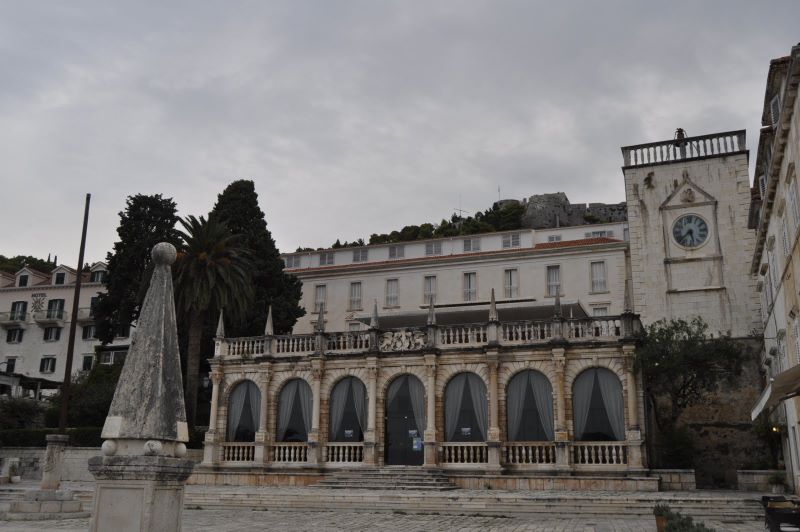
This palace was built in Venetian Renaissance style. In the 19th
century, the Austrians destroyed all but this loggia. We'd guess that
the lions of St. Marks -- symbols of Venice -- were restored sometime
after they left.

The loggia is now one of the fanciest Florida Rooms in the world and
serves as a reception area for a hotel. The original palace was
destroyed when the Ottomans visited in the 16th century. It looks over
a small marina between the square and the harbor.

This was once a fortified governmental complex of five buildings but
only the loggia and the 15th century clock tower remain. After the
Turks left, Croat mason Trifun Bokanić rebuilt the palace. He lived on
the island of BraÄ, just north of Hvar.Supposedly the empty flagpole at
left was called the "Pillar of Shame" back in the middle ages when we
had some. If you messed up, you were tied here while people spit on
you. In Europe now, Hvar has sort of a Florida spring break reputation
and water taxis will take you and your cooler to nude beaches near by.
We didn't see anyone spit while we were here.

This side view of the Rector's palace shows the path through the city
walls and a palace originally built right in the city's walls now being
reconstructed. This arch was the main town gate and was called the
Porta del Datolo because even then (as now) it has palm trees planted
in front of it. Beyond this arch, the pedestrianized street rises to
the Spanish fort.
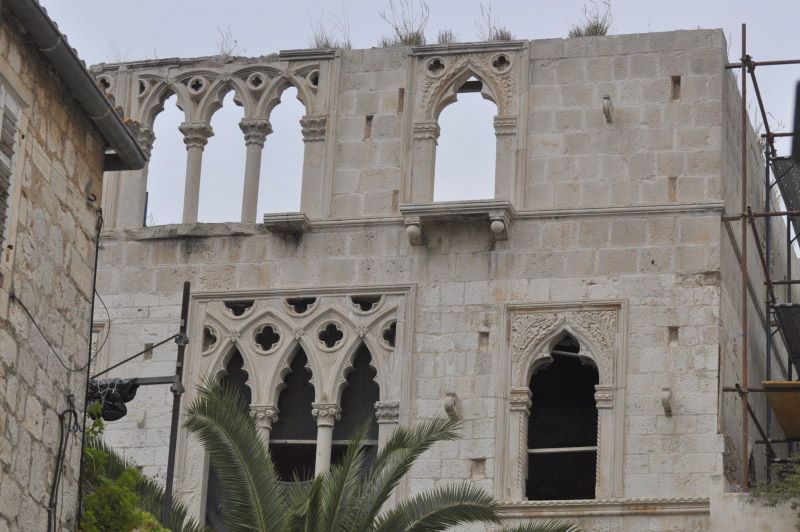
This palace was intended to be the summer home of the family of
Croatian Renaissance poet Petar Hektorović. (Remember that heavy
fortress we saw earlier in the old town of Stari Grad)? His roofless
residence has a much lighter feel with perhaps the finest Venetian
Gothic windows in Hvar. Work stopped at Hektorović's death four
centuries ago-- and never started back up! Like many noble palaces
here, it's built right into the defensive walls of Hvar.
Perhaps it was unfinished because another noble built the building we see at left between Hektorović's house and the harbor, ruining his view. The family was the Paladinićs and the resulting case lingered in the courts. This was their summer home, kitty-corner from their winter home. Apparently the wealthy had two homes close to each other with better ventilation needed for the hot summers. Without a roof, the Hektorović summer home is superbly ventilated. It is somewhat amazing that its walls have held up so long without a roof.

This view of the north side of Hvar's harbor shows an orphan church
tower, most likely the work of Tripun Bokanić who rebuilt the Rector's
palace. The French abolished its monastery in 1807.
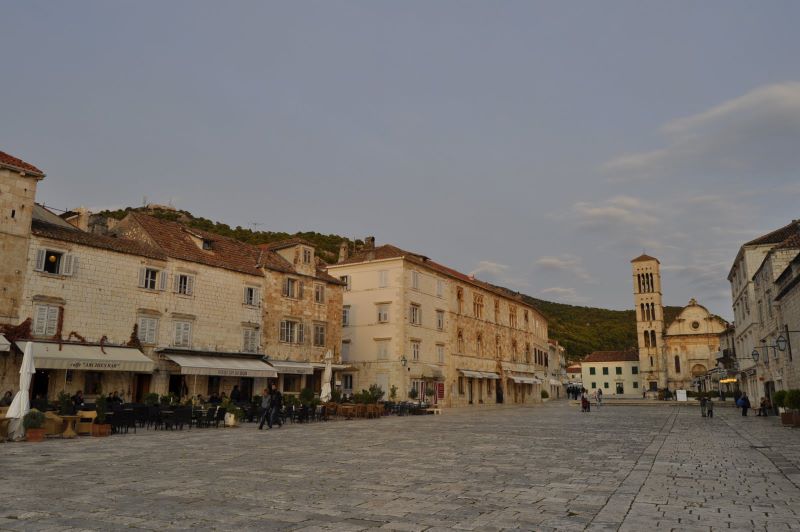
Beyond the Rector's loggia starts the largest square on the Adriatic
except for St. Mark's square in Venice. Second largest is a long way
from the magnificence of St. Mark's but Hvar's square is quite pleasant
and relatively empty while we were there. Trendy bars and restaurants
stick awnings out from the rather simple structures that edge the
square.
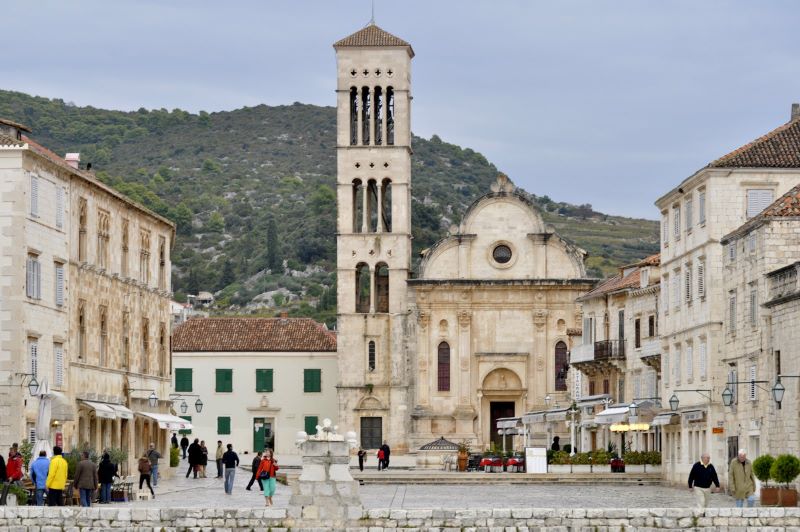
Another view of St. Stephen's Square, named after its cathedral which
was rebuilt starting in 1560. It incorporates sections of the
Benedictine church that preceded it. At the left of the bell tower is
the bishop's palace, now a museum.
Even though Hvar was under Venice's thumb, in 1610 it agreed to give commoners equal political standing with the nobles -- a pretty radical idea for its time (and are we sure we have it today?) Contrast this with the "independent" republic of Dubrovnik nearby which required officeholders to be nobles.

This square was created in 1780 by filling in a marshy bay after
creating a cistern to hold rain water and paving it with stones. The
stored rainwater was then accessed through the ornate fountain at
right. By then, Venice had moved its fleet and the town would languish
until a century later when it became a tourist center.

Here the cistern cover frames the tourists idling in St. Stephen
square. Nearby excavations show traces of a town from around the 5th
century BCE.
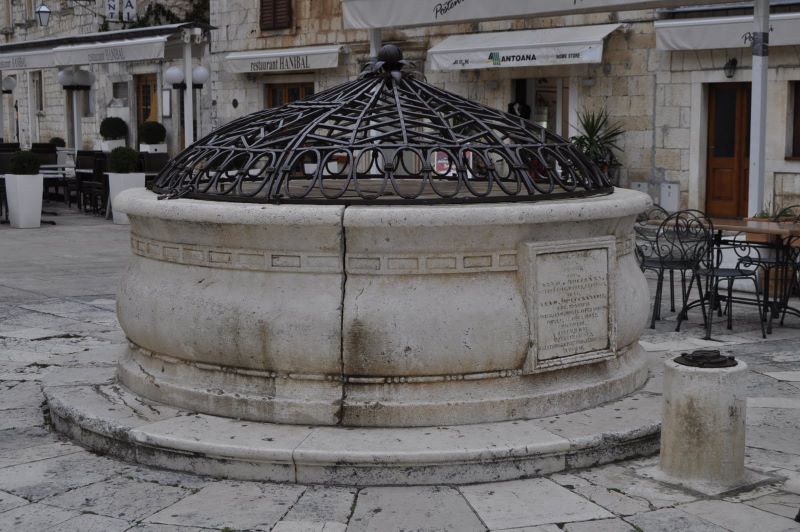
Supposedly this water collection system still served the town until 21
years ago when a modern water system was installed. Still this 1520
font is much more elegant than a bunch of pipes.

In this Venetian town, the tri-font cathedral facade resembles that of
St. Zaccaria in Venice (as did the church of St. Stephen in Stari
Grad.) The nearby island of KorÄula provided many of the
mason/architects for Hvar's monuments. That was the case here: the
facade was worked on by Nikola Karlić in 1541 -- followed by his
fellow islander Ivan Pomenić nearly a century later. With its tower,
the facade makes the exterior the quintessential Dalmatian church.
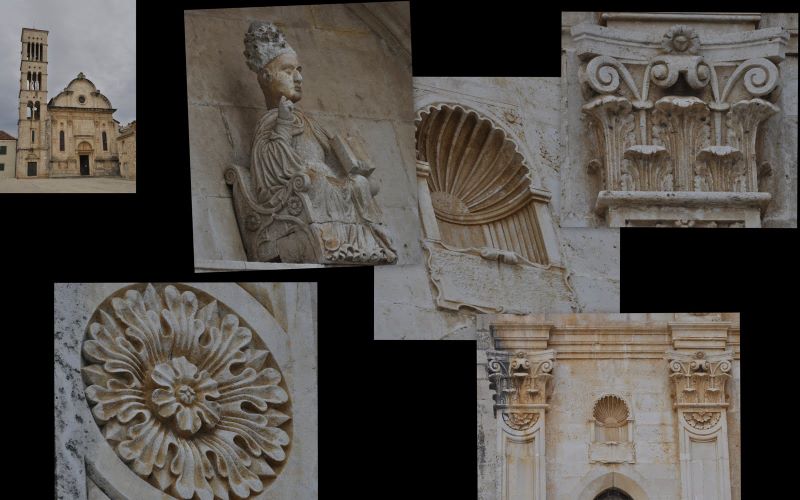
Above are some of the details of Nikola Karlić and Ivan Pomenić's
facade. The statue is most likely of the cathedral's namesake, Pope
Stephen, a saint from the 3rd century whose fashion contributions we
discussed on the old cathedral in Stari Grad.
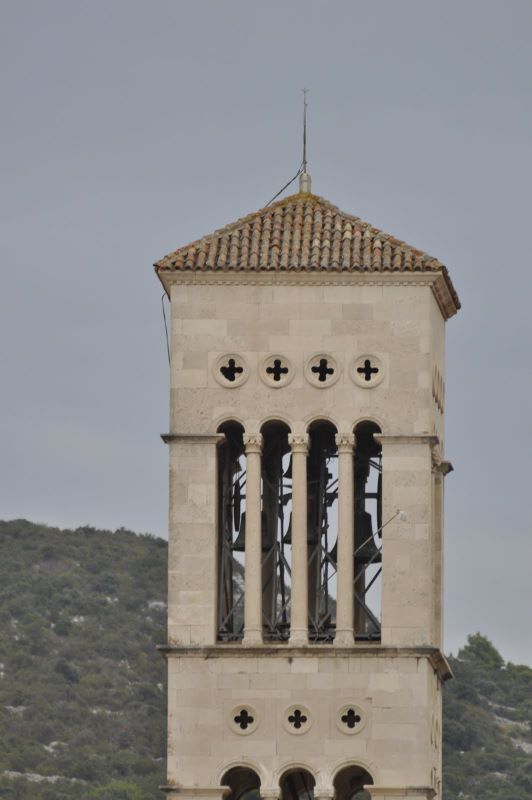
The cathedral bell tower was completed in 1532 (before the facade.) It
echoes the prototype built 25 years earlier by the Franciscan monastery
across the bay. (Why do you need a lightning rod in Europe's sunniest
spot? In case God's aim is off the mark when he strikes at the
sybaritic 3-S tourists. "True story!")

Priestly vestments, gold crosiers, and other treasures are kept next
door to the church in a museum made from the bishop's palace.

Let's go through the low relief bronze doors to see the interior of St.
Stephen Cathedral. These are the work of Kuzma KovaÄić who was born in
Hvar, in 1952. Many of the scenes appear to be of the life of the saint
who would eventually become Pope Stephen, whom this church honors.
(Most of us were inadvertently familiar with KovaÄić's work as we had
Croatian kuna coins in our pockets with his initials "KK" on them --
and had used them to get a little low relief ourselves in some of the
pay toilets in Dubrovnik.)

Somewhat small for a cathedral, St. Stephan's has a Venetian baroque
interior with its nave and two aisles. This was built in stages during
the 16th and 17th centuries on the foundations of a monastery. The
pulpit is from the 15th century.

The side aisles create smaller but open chapel spaces including one
with the family tomb of the writer Hektorović's family. The side
altars are typical Baroque assemblages of inlaid marble beneath oil
paintings framed in multi-colored marble Corinthian columns. Most
paintings are by Venetians and 8 of the 10 altars here are 17th century
products of the workshop of Alessandro and Paolo Tremignon who are
perhaps best known for their Palazzo Labia in Venice. Above, the angel
in the painting holds another framed oil of Christ being laid in the
sepulcher.

The wooden choir stalls are from 1572 (the year after the Ottoman Turks
came by) and suggest that the cathedral canon was fairly small. These
are the work of Venetian Marko Anto and were restored in 1888.
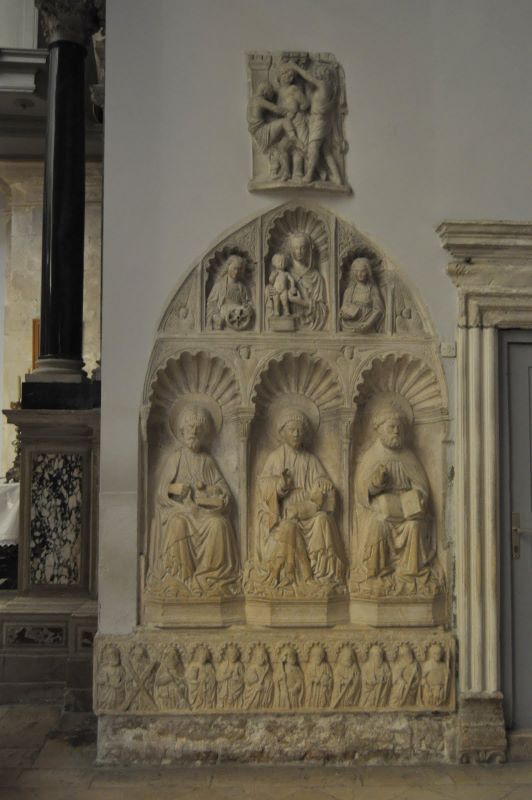
This stonework rising above a relief of the apostles may have been from
an earlier cathedral. At top is a Passion scene of the flagellation of
Christ which is by (or at least in the style) of an important Croat
sculptor Giorgio da Sebenico best known for his masterpiece: the
cathedral at Å ibenik.
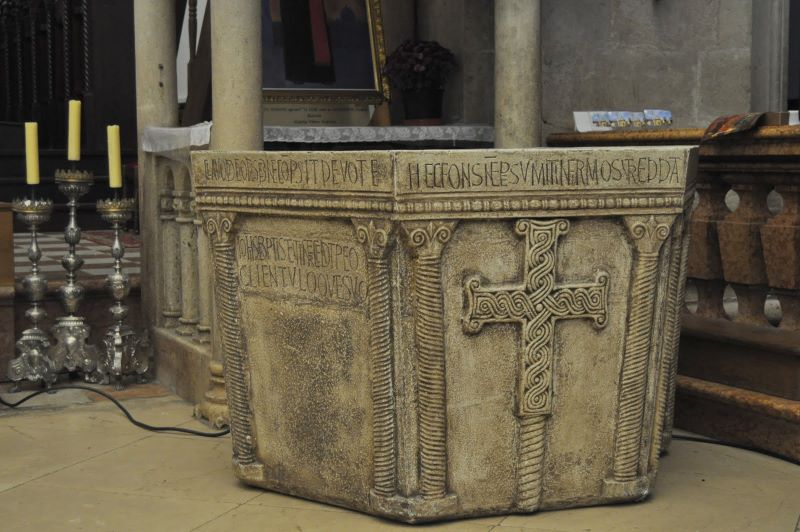
Above is a replica of a medieval baptismal font dating from the 9th
century. This high hexagon is decorated by braided reliefs typical of
Croatian wattle or "pleter." The braided cross is called the Croatian
Cross and dates as a symbol over 1000 years. The original is in the
archeological museum at Split.

Next to the baptismal fount along the marble sanctuary railing, in
ironic juxtaposition, we find modern sound equipment that could use a
little braiding or some other organization. It demonstrates that Hvar
Culture now includes modern liturgical singing.
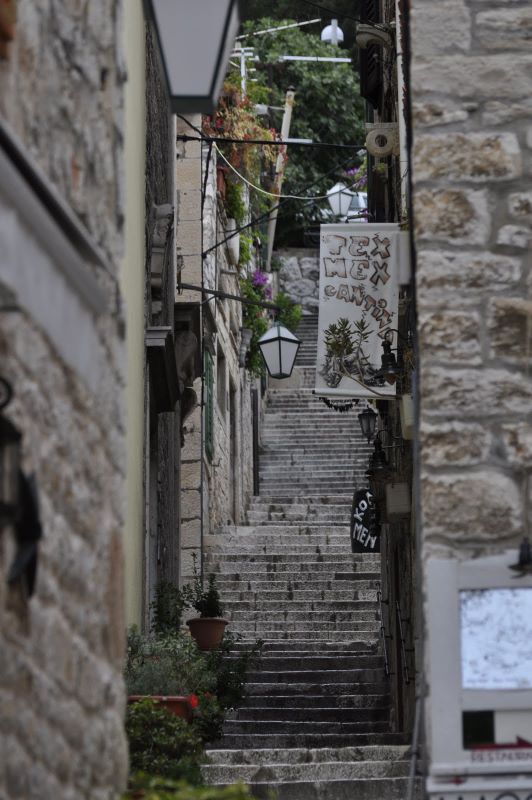
Let's look at some of the typical streets of Hvar including the Tex-Mex
restaurant advertising here. These steps climb up to the Spanish fort.
Most of the town has been pedestrianized.

Some ways of making money from the tourist trade are ingenious. Above
is the flower of the Aloe plant the leaves of which produces a spidery
sap that can be spun into thin threads...
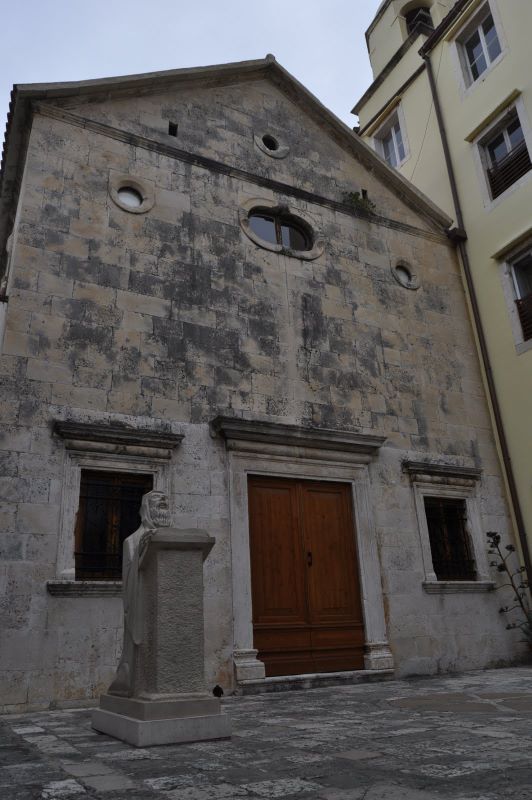
...that nuns in this simple convent weave into incredibly detailed lace
and sell to passers-by. (Photos inside were not allowed.) European lace
making has been going on since the Renaissance -- often by nuns and
noble women. Hvar's Benedictine convent is the only site for aloe based
lace which UNESCO characterizes as part of Croatia's "intangible
cultural heritage" in an obvious attempt at saving lace. Aloe lace
making started in the mid 19th century. If you'd like to see more,
check out the Croatian Ethnographic Museum's excellent 10-minute video by clicking here.
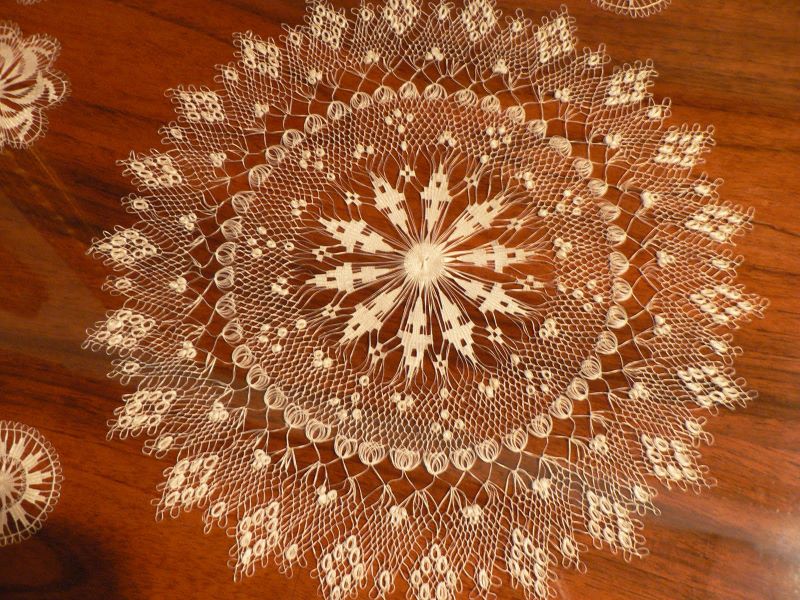
The nuns forbid pictures inside their convent but I found this one on
the web, taken by a fellow Picasaweb user named Cory who was in Hvar
the week before us. (Not much other information is given). Despite
UNESCO's best intentions, this may be a dying art. All postulants at
the convent are required to learn the craft but it's not clear there is
any other strategy to transfer the knowledge of this craft. Given how
few nuns there are in the world, should they be making lace for
tourists?

Let's walk through parts of the old town -- filled with medieval,
Renaissance and Baroque mansions. Venice's winged lion makes frequent
appearances in this town that it ruled for many centuries. Here he
looks rather ugly but not as ugly as...

...this juxtaposition of an old iron "X" bar to help the building survive earthquakes next to an air conditioner.
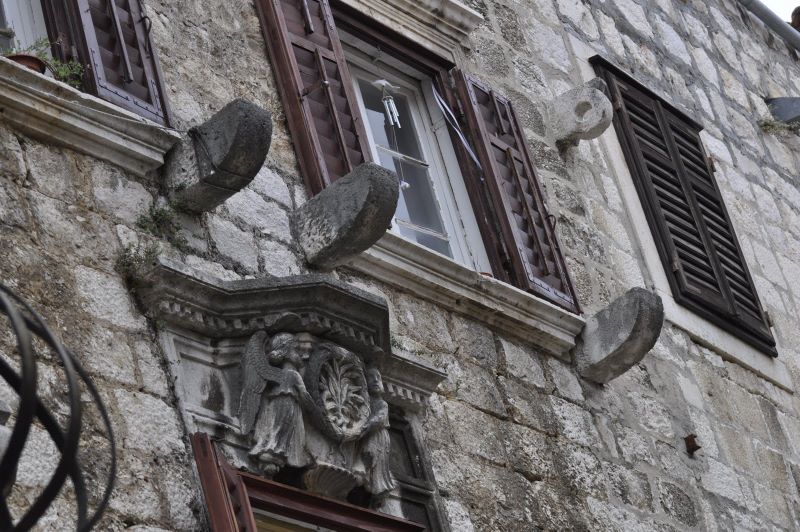
Most of the older homes project beams to support balconies and window
ledges which may have disappeared. Door decorations such as these are
not uncommon.

Stations of the cross lead out from the St Francis Monastery (now a
museum). These were built by the commander of Venice's Adriatic fleet
which was stationed in Hvar for centuries. Today these are scrupulously
maintained and integrated into the streetscape in this nation where 88%
of the population are Roman Catholic -- and unlike in Italy across the
Adriatic, most of these practice.
Religion was often the glue to hold the sense of nation together while 30 different foreign powers tried to rule this island. As we see from its Roman numeral...

...this is the 12th station containing what appears to be a modern
bronze depiction of the crucifixion. The station houses are much older,
being built in 1720.

Backtracking through the stations of the cross, we arrive at its
origin: the former Franciscan monastery. Built from 1461-1471, this
served as a hospice for sailors funded by the captain of the Venetian
fleet. It's outside the old town walls but on the harbor. (It got its
own walls in 1574 but that didn't keep the Ottomans from doing their
mischief in 1571.)

Marko Andrijićbell from the nearby island of KorÄula started (and his
brother finished) the monastery's bell tower around 1500. It serves as
a prototype for many Dalmatian towers and it is not by accident that
the Cathedral tower built 25 years later on the other side of the
harbor resembles it. Only two monks live here now.
The monastery is a museum today -- not just because of what it holds, but because of what the architects included in the construction.

A modern bronze of Francis prays without birds in the outer garden,
perhaps a work of the great Croatian-American artist Ivan Meštrović.
This reflects the poverty promulgated by Francis...

...better than this much older lunette ...

...which, nevertheless, is quite lovely and well maintained except for
the fuzzy angel on the right. Check the foliage below it. This
monastery was dedicated to the Immaculate Conception.This is a copy of
the 1470 original by Nicholas of Florence which has been moved to
Zagreb. Nicholas was a student of the great early Renaissance sculptor
Donatello -- who pioneered this shallow relief sculpture (bas-relief)
technique we see deployed here.

Its 15th century cloister is quite somber --check the decorated well at
lower right and the sundial above. One of the two monks living here is
the sculptor Jaokim Gregof who works in bronze. Are you wondering if
those stations of the cross that lead to this site are his? Or maybe
that Meštrović-ish sculpture of St. Francis?The courtyard is used for
concerts in the summer and we found it bristling with white plastic
chairs.

Inside the church we have a graphic novel's worth of icons including
the scenes from the Passion at top. These twin altars frame the doorway
where the larger outer chapel enters an inner chapel and serve, more or
less, as a choir screen to separate the nave from the sanctuary area.
Both these altar pieces and that showing in the inner chapel are by
Francesco Rizzo Da Santacroce who did much work in Bergamo and Venice.

Here's a twisted view of what we had to settle for before the invention
of Powerpoint. These Passion scenes line the top of the chapel in their
Baroque frame. This is the 1607 work of Martin Benetović, a native of
Hvar -- a town we were beginning to think had a lot of sculptors and
writers, but not many painters.

The inner chapel has this elegant communion rail and leads to the tomb
of an important Croatian Renaissance poet and playwright, Hanibal
Lucić who died in 1553, about the time this church was built. He lived
his entire life in Hvar -- and burnt most of his work. His son was able
to save a bit of his work and publish it, including the first South
Slav secular play.

Meštrović would probably appreciate this sculpture but the museum
seems content to leave it sitting on the floor, at least for now.

Tourists love the old dining room. Like any good monks' refectory, it
has its mural of the Last Supper, this one about 25 feet wide.

Not a fresco, this appears to be a set of canvas panels, some of them
reasonably well restored. There is some debate as to the identity of
the painter although many scholars think it's heavily influenced by the
Venetian Palma Giovane who died in 1628. Palma did several religious
works in Croatia including an 8-paneled altar painting in Hvar. Our
guide thought that this was done by a local since it was unsigned.
Venetians working here typically would sign their paintings.

The refectory leads to a small garden facing the harbor. It features
this 400-year-old cypress with strips of red in its bark (which are not
all that apparent in this picture.) A local story holds that the
painting of the Last Supper was done by Matej Ponzoni-PonÄun who
planted this tree at the same time.

A parting thought: Unlike that Venetian city with a large plaza on the
water, this is a real town with real kids herded by their teachers. (At
least these didn't look like a tour group.)
Although much of the Hvar economy is now somewhat tourist driven, the 11,000 people who live here also produce red and white wines that many consider to be Croatia's best; commercial fishing employs many as well.
The local tourist industry brags that it started in 1886 when the Austria-Hungary empire decided to advertise this location as a health resort. In fact, its roots are much older. During the middle ages, most European pilgrims to the Holy Land started in Venice whose galleys would take them along the shore for provisions and lodging. Hvar was clearly on the way.

Thanks for visiting this sunny but chilly island with us.
|
Please join us in the following slide show to give HvarDefensive Walls the viewing they deserve by clicking here. |
Geek and Legal StuffPlease allow JavaScript to enable word definitions. This page has been tested in Internet Explorer 8.0, Firefox 3.0, and Google Chrome 1.0. Created on January 28, 2010 |
 |